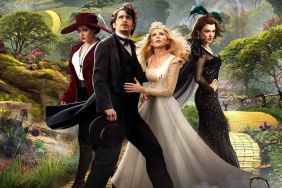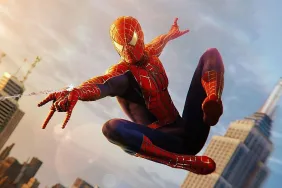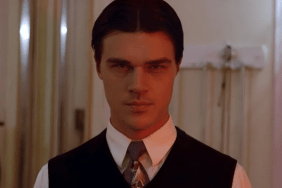“I cannot understand why you should wish to leave this beautiful country and go back to the dry, gray place you call Kansas,” the Scarecrow tells Dorothy in L. Frank Baum’s 1900 novel “The Wonderful Wizard of Oz.”
“That is because you have no brains,” Dorothy responds. “No matter how dreary and gray our homes are, we people of flesh and blood would rather live there than in any other country, be it ever so beautiful. There is no place like home.”
Although the line, “There’s no place like home” is better known today for its use in Victor Fleming’s 1939 big screen musical adaptation of the text, the novel’s sentiment is one that’s hard to dismiss when stepping through the entrance of Pontiac’s Raleigh Michigan Studios. It’s here that Sam Raimi, a Michigan-native-turned-Hollywood-director is mounting a massive Walt Disney Pictures production that is making use of the entire seven-stage facility to film the upcoming Oz The Great and Powerful. Raimi has found a way not just to return home but to travel to Oz as well and, in late 2011, ComingSoon.net had the opportunity to stop in and pay him a visit.
“I love Michigan,” says Raimi during a break from shooting “…I would have stayed here forever, but the film business back then just was not here. So I had to move to Los Angeles. But I love the trees in the fall, the rain and the gray skies, and I like the cold… I’d make all the movies I could here. I just love it.”
Coming off the tremendous success of Tim Burton’s Alice in Wonderland, producer Joe Roth had plans to bring to the screen a new vision of Baum’s fantasy world and Raimi was quick to sign on.
“It’s a fun, family adventure and it seems like whatever that Disney image is, this really does feel like it’s right for them,” the director continues. “…I told them very early on, after working on the script for a couple months, ‘I’m committing to this picture. I intend to make it. I’m going to put everything I’ve got into it. I really believe in it.'”
Although Alice in Wonderland was largely filmed against green screen, it was important to Raimi to actually build as much of Oz as possible through physical sets. A walk through a few of Raleigh’s stages revealed a number of diverse environments including a dark, creepy forest with the Yellow Brick Road running through the middle of it, a full-scale river embankment where James Franco’s Oscar Diggs crashes his hot air balloon after arriving in Oz and a majestic, multi-layered Emerald City throne room.
“We’re trying to create something that pays respect to what we all know as ‘The Wizard of Oz,'” says art director Robert Stromberg, “but that also adds new elements that perhaps a new generation would appreciate and allows us as fans to see maybe things that were around the corner that we didn’t get a chance to see in the original film… The original movie was actually fairly rudimentary in art direction. I mean our minds tend to fill in the blanks, but if you really look at it, it’s really great and then as a child it seems full, but now that I’ve studied it, its in some ways pedestrian. Which is very theatrical stage-like and I love that. And the whole reason we’re on sound stages in the first place and not on locations is because I wanted to maintain the artifice of that. Which means building sets on a lit soundstage, because there’s a very specific look that happens when you do that.”
Stromberg, who also served as art director on Alice in Wonderland and Avatar, is now making his directorial debut with Disney’s upcoming Maleficent.

“I’ve actually stumbled into a project that I’ve wanted to do since I was kid,” Stromberg continues. “I’m a big fan, myself. ‘The Wizard of Oz’ was a huge event when I was a kid. The family gathered around the T.V., and it was a once a year very special moment for my particular family, and I never thought in a million years I would actually be building a Yellow Brick Road or having anything to do with this scale of movie. I’m really a very lucky person.”
Oz The Great and Powerful is designed to strike a balance between the original book series and the Oz that people know from multiple adaptations on stage and screen.
“When I came to the project, I had never read any of Baum’s work,” Raimi explains, “and I’ve only read four of the books now. First of all, I so loved the movie The Wizard of Oz’ that I was afraid to read versions of it that were not exactly what I loved so much about the movie. This is very strange. I didn’t want the book to mess up the movie for me. This is where I was at. But then, after I read the screenplay — which I loved — I started to read the books and appreciate Baum’s work. I was so surprised at how exactly [the movie] The Wizard of Oz’ was his first book. His work is fresh right now. It’s brilliant and affecting and the characters don’t need to be refreshed by anybody.”
Certain elements of the Fleming film are strictly off the table from a legal perspective, including the iconic red ruby slippers. Changed for the 1939 film to show off the technicolor of the day, Baum’s original text instead includes a pair of silver shoes that are a focus in Raimi’s film. Eagle-eyed viewers will also spot a number of other subtle homages.
“We don’t have necessarily a scarecrow, a lion or a tin man in our movie,” Stromberg says, “but I’ve tried to inject that into our script… Part of the Emerald City I’ve tried to build to the motif. This lion if you look way over there, there’s a little miniature of a (gates), and there’s a lion head above it. So throughout the whole movie I’m trying to respect those three characters that were in the film that we know and love.”
“Just legally, we’re unable to recreate the images from the film, which is a shame,” Raimi adds, “Because it’s really all about honoring that film and the books. More the film, in my opinion. But, we just had to. So I just got over and thought, The audience is so sharp. They don’t need that.’ I wish I could have used the imagery from the original film to tell those stories about the characters earlier in their lives. We’re not able to. So it was something we had to get over.”
Electing to follow Oz’s story meant that the film could move forward with even greater freedom, telling a story that Baum never detailed in any of his subsequent 13 “Oz” books. To play the young circus-magician-turned-wizard, Raimi re-teamed with his Spider-Man trilogy star James Franco. Franco, dressed in a decidedly worn coat and top hat and backed by the bright contrast of another Yellow Brick Road set, took a moment to recall that he wasn’t the first actor up for the part.
“[Robert Downey Jr.] was signed on, I think,” he says. “Sam said he gave him a plant at the first meeting, and when he went for the second meeting, he saw that the plant had been put aside and it was dead already and that was a bad omen… [So] Downey Jr. had fallen out — I’m not sure why — and then they were talking to Johnny Depp and he didn’t end up doing it. So then I had a meeting with Sam, and I read the script and briefly talked about it. I don’t know, it was just kind of an understanding that we both liked the approach that there was one aspect of it that would pay tribute to the collective sense of ‘Oz,’ but there would be a fresh take.”

“We want him to be an interesting jerk in the beginning,” Stromberg adds, “because our character has to make a really big transition. A really big character arc in the movie where he changes from a selfish man to a selfless man, and one that we are not sure about, and one that we really care about. Through the course of our script we start to learn that he isn’t what we thought he was. We start to learn that he’s a person that we might want to be.”
Playing opposite opposite Franco is Michelle Williams as another familiar Oz name, Glinda. In the scene being shot, she speaks with Oscar in the middle of her kingdom, surrounded by a colorful Quadlings and Munchkins.
“I just think of her as where Glinda started,” Williams says. “When you meet Glinda in the original ‘Wizard of Oz,’ she is omniscient, she has a kind of calm. ..We like to think that that’s where she wound up and this is kind of more where she began.”
Another nod to the Fleming version of the story calls for several of the actors to play dual roles, starring as both their Oz characters and as “real” world people in the black-and-white world of Kansas that opens the film.
“In the circus, [Williams plays] Oz’s childhood sweetheart that he didn’t commit to,” says Stromberg. “He sort of missed that opportunity. As a matter of fact, when we first meet her she’s kind of giving him a chance to do something– because she tells him that she’s going to get married, and gives him the opportunity to stop that. But he decides his ambitions are bigger than that or more important than that.”
Also appearing in the Kansas scenes are Zach Braff as Diggs’ assistant, Frank, and young star Joey King as a little girl in a wheelchair. In Oz, both actors voice CGI characters. Braff becomes Finley, a flying monkey and King is the China Girl, an 18-inch porcelain doll that Diggs discovers in the Baum-inspired Chinatown.
“She’s the last of her town,” explains King. “The last of her family. At first, yes, her legs are broken. She’s very, very sassy. Very sassy. She has some attitude. But she’s also very sweet. Oz first discovers her in Chinatown and he sees her crying there and takes her in with Finley.”
“Doormat’ is a good way to put it,” says Braff of both his characters’ personalities. “As Frank, [Oscar] is the magician and I’m his magician’s assistant. I want acceptance by him, because I look up to him and he is very dismissive and condescending to me and makes it clear he has no interest in being my friend. He just wants a helper. Then we are forced to go on this journey together and Finley is assigned to sort of lookout over Oz by Rachel Weisz’s character, so begrudgingly we go on this quest together and little by little he can’t help but be charmed by this little flying monkey.”
Raimi employed an innovative technique to bring Finley and the China Girl to life. Just outside one of the soundstages, Braff and King have their own special trailer with video booths on either side. Both talents are able to interact with the cast on-set through monitors placed at the proper heights, meaning that actors like Franco have someone to actually play against.

Even more impressive is the contribution of puppeteer Phillip Huber, known to movie fans for his work on Being John Malkovich. On set, he controls a marionette version of the China Girl that can even open and close her eyes. Combined with the facial interaction of King, the marionette gives the “human” actors a look at what the CGI China Girl will be doing in the final film. Because Raimi is a big fan of the marionette’s movements, he’s elected not to motion-capture King’s performance in any way. Instead, the final China Girl will be key-framed to mimic the movement of the actual marionette.
The multi-tiered approach to the material is designed to blend modern technology with a century of tried and true filmmaking techniques. For Raimi, a man who, quite literally, is using his skills as a magician to travel through Oz, it’s not hard to find the personal connection between the artist and his work. In the end, though, Raimi believes that it’s a more universal connection to Oz that will hit home with audiences.
“I have read that people consider Baum’s ‘The [Wonderful] Wizard of Oz,’ his first book, America’s first myth or America’s first fairy tale,” Raimi puts it. “…I think it’s universal. The story of all of us who are capable of doing good and the hero being made because he recognizes that ability within himself and he grows to do something greater than himself. He grows to take part in a cause that’s more important than his selfishness or his greed. He learns the true value of the gifts that he’s been given as a magician.”
Fans can decide for themselves the true value of Raimi’s own magic when Oz The Great and Powerful hits theaters on March 8.









